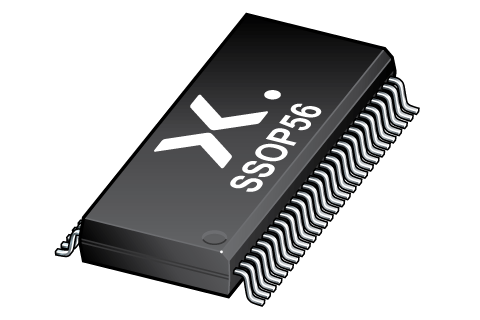
Register once, drag and drop ECAD models into your CAD tool and speed up your design.
Click here for more information74LVT16543ADL
3.3 V 16-bit registered transceiver; 3-state
The 74LVT16543A is a 16-bit registered transceiver with 3-state outputs. The device can be used as two 8-bit transceivers or one 16-bit transceiver.
Data flow in each direction is controlled by intput enable (nEAB and nEBA), latch enable (nLEAB and nLEBA), and output enable (nOEAB and nOEBA) inputs. For A to B data flow, the device operates in the transparent mode when (nEAB) and (nLEAB) are LOW. A subsequent LOW-to-HIGH transition of the nLEAB input latches the data and the outputs no longer change with the inputs. A HIGH on either nEAB or nOEAB causes the outputs to assume a high-impedance OFF-state.
Control of data flow from B to A is similar, but using the nEBA, nLEBA, and nOEBA inputs. Bus hold data inputs eliminate the need for external pull-up resistors to define unused inputs
Features and benefits
16-bit universal bus interface
3-state buffers
Wide supply voltage range from 2.7 to 3.6 V
Input and output interface capability to systems at 5 V supply
Overvoltage tolerant inputs to 5.5 V
Direct interface with TTL levels
BiCMOS high speed and output drive
Output capability: +64 mA/-32 mA
Bus-hold data inputs eliminate the need for external pull-up resistors to hold unused inputs
Live insertion/extraction permitted
Power-up 3-state
Power-up reset
No bus current loading when output is tied to 5 V bus
IOFF circuitry provides partial Power-down mode operation
Latch-up performance exceeds 500 mA per JESD 78 Class II Level B
Complies with JEDEC standards
JESD8C (2.7 V to 3.6 V)
ESD protection:
HBM: JESD22-A114F exceeds 2000 V
MM: JESD22-A115-A exceeds 200 V
Parametrics
| Type number | Product status | Package name |
|---|---|---|
| 74LVT16543ADL | End of life | SSOP56 |
PCB Symbol, Footprint and 3D Model
| Model Name | Description |
|---|---|
|
|
Package
All type numbers in the table below are discontinued. See the table Discontinuation information for more information.
| Type number | Orderable part number, (Ordering code (12NC)) | Status | Marking | Package | Package information | Reflow-/Wave soldering | Packing |
|---|---|---|---|---|---|---|---|
| 74LVT16543ADL | 74LVT16543ADL,112 (935182750112) |
Obsolete | LVT16543A |

SSOP56 (SOT371-1) |
SOT371-1 |
SSOP-TSSOP-VSO-REFLOW
SSOP-TSSOP-VSO-WAVE |
Not available |
| 74LVT16543ADL,118 (935182750118) |
Obsolete | LVT16543A | Not available | ||||
| 74LVT16543ADL,512 (935182750512) |
Obsolete | LVT16543A | Not available | ||||
| 74LVT16543ADL,518 (935182750518) |
Obsolete | LVT16543A | Not available |
Environmental information
All type numbers in the table below are discontinued. See the table Discontinuation information for more information.
Series
Documentation (6)
| File name | Title | Type | Date |
|---|---|---|---|
| lvt16543a | lvt16543a IBIS model | IBIS model | 2013-04-07 |
| Nexperia_package_poster | Nexperia package poster | Leaflet | 2020-05-15 |
| SOT371-1 | plastic, shrink small outline package; 56 leads; 0.635 mm pitch; 18.45 mm x 7.5 mm x 2.8 mm body | Package information | 2020-04-21 |
| SSOP-TSSOP-VSO-REFLOW | Footprint for reflow soldering | Reflow soldering | 2009-10-08 |
| lvt16 | lvt16 Spice model | SPICE model | 2013-05-06 |
| SSOP-TSSOP-VSO-WAVE | Footprint for wave soldering | Wave soldering | 2009-10-08 |
Support
If you are in need of design/technical support, let us know and fill in the answer form we'll get back to you shortly.
PCB Symbol, Footprint and 3D Model
| Model Name | Description |
|---|---|
|
|
How does it work?
The interactive datasheets are based on the Nexperia MOSFET precision electrothermal models. With our interactive datasheets you can simply specify your own conditions interactively. Start by changing the values of the conditions. You can do this by using the sliders in the condition fields. By dragging the sliders you will see how the MOSFET will perform at the new conditions set.
